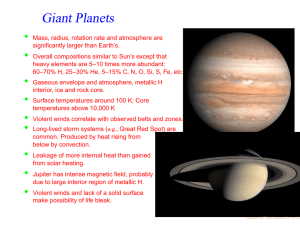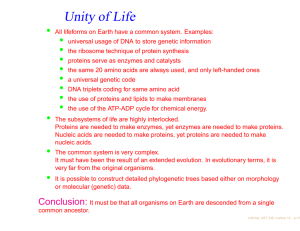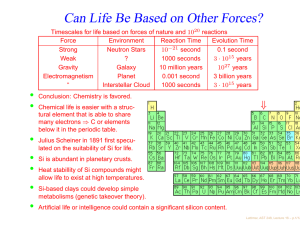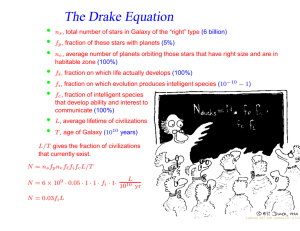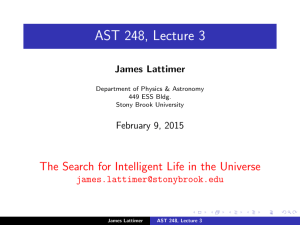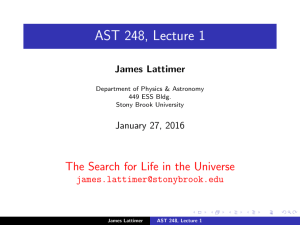Spaceflight Rocket Formula: v = s ln
advertisement
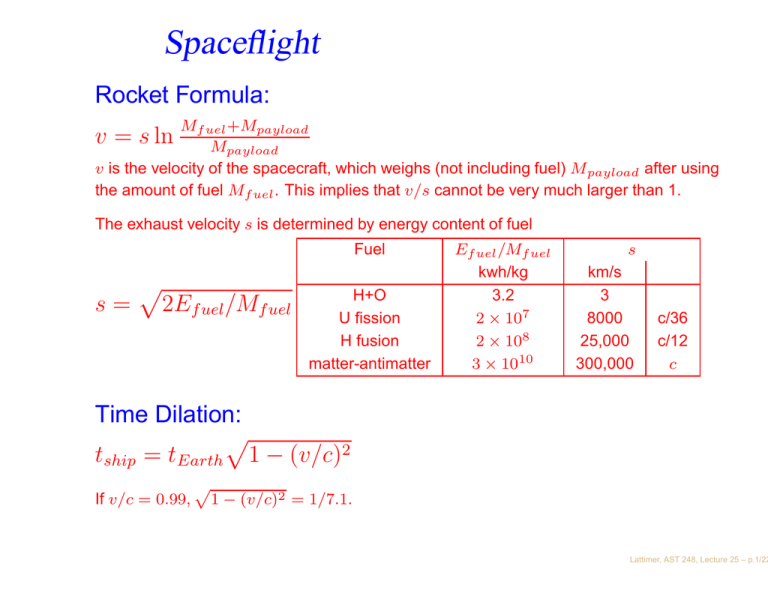
Spaceflight Rocket Formula: Mf uel +Mpayload v = s ln Mpayload v is the velocity of the spacecraft, which weighs (not including fuel) M payload after using the amount of fuel Mf uel . This implies that v/s cannot be very much larger than 1. The exhaust velocity s is determined by energy content of fuel Fuel s= p 2Ef uel /Mf uel H+O U fission H fusion matter-antimatter Ef uel /Mf uel kwh/kg 3.2 2 × 107 2 × 108 3 × 1010 s km/s 3 8000 25,000 300,000 c/36 c/12 c Time Dilation: p tship = tEarth 1 − (v/c)2 p If v/c = 0.99, 1 − (v/c)2 = 1/7.1. Lattimer, AST 248, Lecture 25 – p.1/22 Time Dilation • A light is emitted from a source, reflected by a mirror, and detected by a detector. The mirror is a distance d from the light source. • Observer Lou sees the light source, light detector and clock all located at exactly the same location. The time interval he notes between emission and detection is tLou . • Observer Sue sees the light source, mirror and light detector all travelling to the left with a velocity v. The time interval she notes between emission and detection is tSue . • According to Lou, the light must have travelled a distance of 2d. At speed c, this takes a time tLou = 2d/c. • According to Sue, who sees everything move a distance vt Sue in between emission and detection, the light must have travelled a distance p ctSue = 2 (vtSue /2)2 + d2 so that tSue = 2dγ/c, where γ = (1 − (v/c)2 )−1/2 . • tSue = tLou γ Lattimer, AST 248, Lecture 25 – p.2/22 Relativistic Travel The time lapse between two events is relative, e.g., the twin paradox. Time dilation Two events happening in different locations that are simultaneous to one observer need not be simultaneous to another. Relativity of simultaneity The dimensions of an object as measured by one observer may be different than measured by another observer, e.g., the ladder paradox. Lorentz contraction Each twin sees the other as moving and having a slower clock. However, the traveling twin undergoes an acceleration to change direction which destroys the symmetry. He has fewer clock ticks than his twin. Twin Paradox r Lattimer, AST 248, Lecture 25 – p.3/22 Round-Trip Voyages at 1g Accelerate at 1g halfway to destination; decelerate at 1g. Repeat to return to Earth. τ Elapsed Time on Ship (yrs) 1 2 3 4 5 10 20 30 40 50 100 t Elapsed Time on Earth (yrs) 1.01 2.08 3.29 4.70 6.41 24.2 296.8 3613 44,100 535,900 1.44 · 1011 v/c Maximum Velocity .245 .462 .635 .762 .848 .987 .9999 1 1 1 1 d Maximum Distance Reached (lt.-yrs) .063 .255 .59 1.08 1.77 10.26 146.4 1805 22,050 2.68 · 105 7.2 · 1010 γ (Maximum) 1.03 1.13 1.29 1.54 1.89 6.13 74.2 903 11,025 1.34 · 105 3.6 · 1010 Lattimer, AST 248, Lecture 25 – p.4/22 Problems with Interstellar Space Travel 1. Vast Distances: Nearest star (α Cen) is 4.3 lt.yr. (1.4 pc) distant. With v = 0.1c = 30, 000 km/s, need 43 years to reach it. 2. High Velocities require lots of fuel. For chemical fuel and M payload = 100 tons: Mf uel /Mpayload ' ev/s = e10,000 = 8.6 × 104340 Mf uel ' 8.6 × 104348 g = 4.3 × 104315 M ' 104259 MU niverse !!! For nuclear fuel Mf uel /Mpayload ≈ ev/s − 1 = e1.2 − 1 = 2.3 With matter-antimatter fuel, s = c, must use relativistic rocket formula: q Mf uel +Mpayload c+v = , c−v M payload v = 0.1c requires Mf uel /Mpayload = 0.11. Where do you get 11 tons of antimatter? 3. Total energy to accelerate Titanic (m = 10 11 g) to v = 0.1c and slow down: mv 2 = 1011 (3 · 109 )2 erg = 1030 erg = 100× Earth’s annual energy usage. 4. Even moderate accelerations with high exhaust velocities require enormous power. Assume Mpayload = 100 tons, acceleration is 1g, exhaust velocity is c/12: Power = Mpayload gc/24 = 12, 250 Gigawatts. This is equivalent to 2450 Hoover Dams, or to 40% the present world-wide energy consumption rate. Lattimer, AST 248, Lecture 25 – p.5/22 Alternate Proposals H-fusion has s = c/12 Thrust = Mship × acceleration = Fuel collection rate ×s Fuel collection rate = collector area ×v× density (n) Acceleration = 1g ; v = 0.01c Mship = 10 tons; n = .1 atom H/cm3 = 1.6 · 10−25 g/cm3 Collector area = gMship /(svn) = 1016 cm2 (a circle 300 km in radius). Interstellar Ramjet (Bussard) Solar Sails Usable power of sunlight is R R d L (Rship /2d)2 = 43, 000( 100ship )2 ( 1 AU )2 Gw = 10−3 ( 100ship )2 ( 1 dpc )2 Mw km km For 1g acceleration, needs power of gMship c/2 = 1.5 · 106 Mw Effective L could be enhanced by using giant solar collectors and reradiating power with lasers and/or lenses. SiC or C fibers, with mass of 10–100 g. A few Hoover Dams of power could accelerate this at more than 100 g’s; velocities of 0.2 c are reached within a week, and nearest stars are reached in 20 years Earth-time. Nanotechnology Lattimer, AST 248, Lecture 25 – p.6/22 Practical Proposals Robert L. Forward, AAAS Annual Meeting, May 1986 Lattimer, AST 248, Lecture 25 – p.7/22 Requires exotic matter, which has negative energy density and repels normal matter. At present, exotic matter virtually exists under some conditions, and may have been the normal state of matter prior to the inflationary epoch in the Big Bang. Exotic matter could repel normal-matter spaceships to faster-than-light travel without violating causality and without permitting time travel. Such travelers would experience neither accelerations nor time dilation. Spacetime Hypersurfing Otherwise known as “Action at a Distance”. Some recent experiments seem to show that mass can influence other mass, no matter how distant it might be, virtually instantaneously. Perhaps this quantum mechanical effect could be utilized for “faster-than-light” travel. Very speculative. Quantum Entanglement A German theoretical physicist developed an idea for a propulsion device that could travel faster than light using extra dimensions contained in his theory. The theory has made a number of interesting, correct predictions about subatomic particles, but otherwise has not been verified. Few people really understand it and it remains speculative and controversial. Burkhard Heim’s unified field theory Lattimer, AST 248, Lecture 25 – p.8/22 Using Black Holes Schwarzschile (non-rotating) black hole Kerr (rapidly rotating) black hole Lattimer, AST 248, Lecture 25 – p.9/22 The Fermi Paradox The apparent contradiction between high estimates of the probability of the existence of extraterrestrial civilizations and the lack of evidence for, or contact with, such civilizations. • Drake equation arguments support the idea that the Earth is not special and that large numbers of ET civilizations exist. • • Intelligent life will explore space and tend to colonize new habitats. The timescale for exploration is not prohibitively large. Spacecraft velocities of 0.01c could be achieved through gravitational slingshots coupled with solar sail propulsion. • Robot probes would be much more efficient than manned probes. If the robot probes (von Neumann probes) could make copies of themselves when they arrive at each stellar system, and send their offspring to further explore, a wave of exploration will propagate (the coral model). t b ≈ 100 years would be an estimate of time needed to build new probes from raw materials of a stellar system. Probes could even carry genetic information needed to populate habitable systems. • Propagation speed is D∗ v s ' 0.0075c, where D∗ ≈ 3 lt. yr., vs ≈ 0.01c, and D∗ +tb vs tb ≈ 100 years. • To explore a sphere of 100,000 lt. yr. diameter would then take 13 Myr if done most efficiently. This is much less than the Galaxy’s age. • • Even with tb = 5000 yr, it would take 170 Myr to colonize the Galaxy. Alternatively, a civilization could construct communication probes (Bracewell probes) and flood the Galaxy with them. Lattimer, AST 248, Lecture 25 – p.10/22 Resolutions • • No other civilizations exist • No other civilizations have been born yet (Rare Earth hypothesis) • Intelligent life destroys itself before exploration ensues (doomsday argument) from nuclear or biological war, contamination, nanotechnological catastrophe, disastrous physics experiments, Malthusian overpopulation • Intelligent life destroys others; to be successful, an alien species will be a superpredator They do exist but we see no evidence • • • • • Humans have not been searching long enough Humans are not listening properly Civilizations may only broadcast for a brief time period Civilizations experience a technological singularity and attain a posthuman character that is uninterested in communication. Robot probes lose their programming or radiation effects alter or destroy them. Aliens choose not to interact with us • Earth is purposely isolated (the zoo and/or sentinel hypotheses) • • It is too expensive to perform the von Neumann or Bracewell search strategies Communication is impossible for technical reasons • • • • Communication is impossible due to vast distances and timing They are too alien or non-technological (or posthuman) They are here unobserved (zoo hypothesis again) Lattimer, AST 248, Lecture 25 – p.11/22 Space Settlements Motivations: • Solar power: An array 100 km on a side can collect Earth’s entire power consumption, worth $3 billion per hour. Energy beamed as microwaves to rectennae which absorb microwaves and convert them to electricity. • • Pharmacology, molecular nanotechnology (diamonoid mechanosynthesis) • • Orbital towers or space elevators possible, would permit low-cost orbital transportation. Could serve as base for space mining. Not practical for reduction of population: world-wide population growth is N (b − d) ' 270, 000 persons per day. Advantages over planetary colonization: • • • • • • Access to perpetual solar energy Access to zero gravity Long-term expansion of land area available to human race. Control of environment Location at top of Earth’s gravity well First step to interstellar colonization Lattimer, AST 248, Lecture 25 – p.12/22 Solar Power Satellites Design Parameters • • Geostationary orbit: 22,300 miles Circular satellite antennae at least 1 km diameter to avoid losses due to diffraction and sidelobes • Elliptical ground antennae (rectennae) about 10 × 14 km, composed of many short dipole antennae connected via diodes. Crops and animals could be raised underneath them, since antennae are thin enough to permit sunlight to penetrate. • Desired microwave intensity is 23 mW/cm2 , so each antenna transfers between 5 and 10 Gigawatts of power. • • Optimum microwave frequency is about 2.45 GHz. With monocrystalline silicon solar cells (14% efficiency), the satellite would need 50 - 100 km2 collector area; 2/3 less if triple junction gallium arsenide solar cells are used. • Major cost is that of space launches. Will be reduced by economies of scale. Mass-to-power ratio would be about 1 kg/kW, or 10 4 tons for each antenna. At present, the launch cost is as high as the energy returns over a 10-year timespan. • • Using materials from the moon or asteroids could ultimately reduce costs. Another strategy for reducing launch costs involves using space elevators. Lattimer, AST 248, Lecture 25 – p.13/22 Solar Power Satellite Lattimer, AST 248, Lecture 25 – p.14/22 Constraints for Space Habitats: • Most material should originate from Moon, or possibly asteroids or comets. Use electromagnetic mass drivers to inject material from lunar surface into Earth orbit. • Earth-normal gravity required in living and most working quarters. Axial area is zero-gee. Diameter must be greater than about 1.8 km to keep rotation rate low. D = 2gP 2 /(2π)2 = 1.8(P/1 min)2 km. • To protect against cosmic rays and solar radiation, shielding of several tons per square foot of exterior surface, which corresponds to about 2–3 feet thickness, is needed. Less could be more harmful than none at all. • • System of mirrors and louvers needed to permit solar lighting and heating. Torus (Stanford), sphere (Bernal), or cylinder (O’Neill) geometry favored because of longer sightlines, lessens claustrophobia, permits weather. Lattimer, AST 248, Lecture 25 – p.15/22 Stanford Torus Lattimer, AST 248, Lecture 25 – p.16/22 Lattimer, AST 248, Lecture 25 – p.17/22 Lattimer, AST 248, Lecture 25 – p.18/22 O’Neill Cylinder Lattimer, AST 248, Lecture 25 – p.19/22 Lattimer, AST 248, Lecture 25 – p.20/22 Bernal Sphere Lattimer, AST 248, Lecture 25 – p.21/22 Lattimer, AST 248, Lecture 25 – p.22/22
